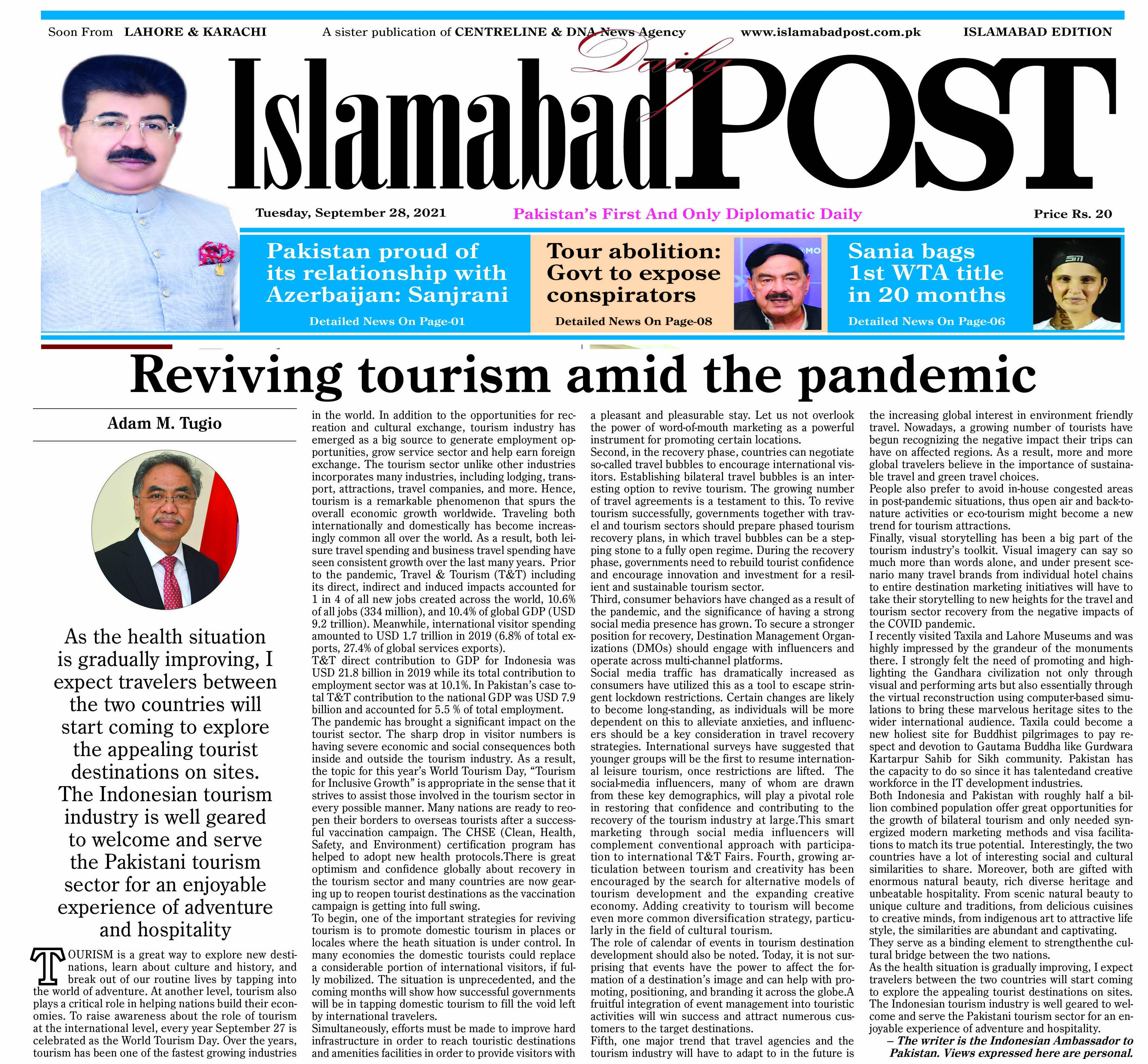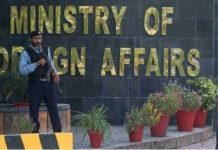As the health situation is gradually improving, I expect travelers between the two countries will start coming to explore the appealing tourist destinations on sites. The Indonesian tourism industry is well geared to welcome and serve the Pakistani tourism sector for an enjoyable experience of adventure and hospitality
Adam M. Tugio
Tourism is a great way to explore new destinations, learn about culture and history, and break out of our routine lives by tapping into the world of adventure. At another level, tourism also plays a critical role in helping nations build their economies. To raise awareness about the role of tourism at the international level, every year September 27 is celebrated as World Tourism Day.
Over the years, tourism has been one of the fastest growing industries in the world. In addition to the opportunities for recreation and cultural exchange, tourism industry has emerged as a big source to generate employment opportunities, grow service sector and help earn foreign exchange. The tourism sector unlike other industries incorporates many industries, including lodging, transport, attractions, travel companies, and more. Hence, tourism is a remarkable phenomenon that spurs the overall economic growth worldwide.
Traveling both internationally and domestically has become increasingly common all over the world. As a result, both leisure travel spending and business travel spending have seen consistent growth over the last many years.
Prior to the pandemic, Travel & Tourism (T&T) including its direct, indirect and induced impacts accounted for 1 in 4 of all new jobs created across the world, 10.6% of all jobs (334 million), and 10.4% of global GDP (USD 9.2 trillion). Meanwhile, international visitor spending amounted to USD 1.7 trillion in 2019 (6.8% of total exports, 27.4% of global services exports).
T&T direct contribution to GDP for Indonesia was USD 21.8 billion in 2019 while its total contribution to employment sector was at 10.1%. In Pakistan’s case total T&T contribution to the national GDP was USD 7.9 billion and accounted for 5.5 % of total employment.
The pandemic has brought a significant impact on the tourist sector. The sharp drop in visitor numbers is having severe economic and social consequences both inside and outside the tourism industry. As a result, the topic for this year’s World Tourism Day, “Tourism for Inclusive Growth” is appropriate in the sense that it strives to assist those involved in the tourism sector in every possible manner.
Many nations are ready to reopen their borders to overseas tourists after a successful vaccination campaign. The CHSE (Clean, Health, Safety, and Environment) certification program has helped to adopt new health protocols.There is great optimism and confidence globally about recovery in the tourism sector and many countries are now gearing up to reopen tourist destinations as the vaccination campaign is getting into full swing.
To begin, one of the important strategies for reviving tourism is to promote domestic tourism in places or locales where the heath situation is under control. In many economies the domestic tourists could replace a considerable portion of international visitors, if fully mobilized. The situation is unprecedented, and the coming months will show how successful governments will be in tapping domestic tourism to fill the void left by international travelers.
Simultaneously, efforts must be made to improve hard infrastructure in order to reach touristic destinations and amenities facilities in order to provide visitors with a pleasant and pleasurable stay. Let us not overlook the power of word-of-mouth marketing as a powerful instrument for promoting certain locations.
Second, in the recovery phase, countries can negotiate so-called travel bubbles to encourage international visitors. Establishing bilateral travel bubbles is an interesting option to revive tourism. The growing number of travel agreements is a testament to this. To revive tourism successfully, governments together with travel and tourism sectors should prepare phased tourism recovery plans, in which travel bubbles can be a stepping stone to a fully open regime. During the recovery phase, governments need to rebuild tourist confidence and encourage innovation and investment for a resilient and sustainable tourism sector.
Third, consumer behaviors have changed as a result of the pandemic, and the significance of having a strong social media presence has grown. To secure a stronger position for recovery, Destination Management Organizations (DMOs) should engage with influencers and operate across multi-channel platforms.
Social media traffic has dramatically increased as consumers have utilized this as a tool to escape stringent lockdown restrictions. Certain changes are likely to become long-standing, as individuals will be more dependent on this to alleviate anxieties, and influencers should be a key consideration in travel recovery strategies. International surveys have suggested that younger groups will be the first to resume international leisure tourism, once restrictions are lifted.
The social-media influencers, many of whom are drawn from these key demographics, will play a pivotal role in restoring that confidence and contributing to the recovery of the tourism industry at large.This smart marketing through social media influencers will complement conventional approach with participation to international T&T Fairs.
Fourth, growing articulation between tourism and creativity has been encouraged by the search for alternative models of tourism development and the expanding creative economy. Adding creativity to tourism will become even more common diversification strategy, particularly in the field of cultural tourism.
The role of calendar of events in tourism destination development should also be noted. Today, it is not surprising that events have the power to affect the formation of a destination’s image and can help with promoting, positioning, and branding it across the globe.A fruitful integration of event management into touristic activities will win success and attract numerous customers to the target destinations.
Fifth, one major trend that travel agencies and the tourism industry will have to adapt to in the future is the increasing global interest in environment friendly travel. Nowadays, a growing number of tourists have begun recognizing the negative impact their trips can have on affected regions. As a result, more and more global travelers believe in the importance of sustainable travel and green travel choices.
People also prefer to avoid in-house congested areas in post-pandemic situations, thus open air and back-to-nature activities or eco-tourism might become a new trend for tourism attractions.
Finally, visual storytelling has been a big part of the tourism industry’s toolkit. Visual imagery can say so much more than words alone, and under present scenario many travel brands from individual hotel chains to entire destination marketing initiatives will have to take their storytelling to new heights for the travel and tourism sector recovery from the negative impacts of the COVID pandemic.
I recently visited Taxila and Lahore Museums and was highly impressed by the grandeur of the monuments there. I strongly felt the need of promoting and highlighting the Gandhara civilization not only through visual and performing arts but also essentially through the virtual reconstruction using computer-based simulations to bring these marvelous heritage sites to the wider international audience. Taxila could become a new holiest site for Buddhist pilgrimages to pay respect and devotion to Gautama Buddha like Gurdwara Kartarpur Sahib for Sikh community. Pakistan has the capacity to do so since it has talentedand creative workforce in the IT development industries.
Both Indonesia and Pakistan with roughly half a billion combined population offer great opportunities for the growth of bilateral tourism and only needed synergized modern marketing methods and visa facilitations to match its true potential.
Interestingly, the two countries have a lot of interesting social and cultural similarities to share. Moreover, both are gifted with enormous natural beauty, rich diverse heritage and unbeatable hospitality. From scenic natural beauty to unique culture and traditions, from delicious cuisines to creative minds, from indigenous art to attractive life style, the similarities are abundant and captivating.
They serve as a binding element to strengthenthe cultural bridge between the two nations.
As the health situation is gradually improving, I expect travelers between the two countries will start coming to explore the appealing tourist destinations on sites. The Indonesian tourism industry is well geared to welcome and serve the Pakistani tourism sector for an enjoyable experience of adventure and hospitality.
The writer is the Indonesian Ambassador to Pakistan. Views expressed here are personal.


















